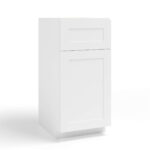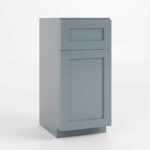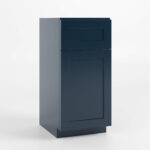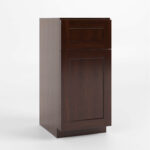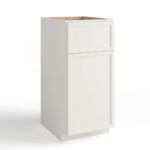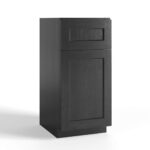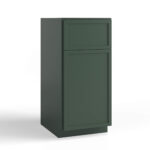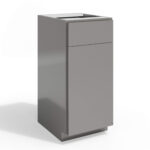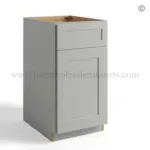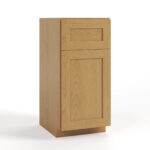Table of Contents:
- Introduction
- Kitchen for a Multigenerational Home
- Meeting Diverse Needs in a Multigenerational Home
- Creating Inclusive Kitchen Designs
- Kitchen Appliances and Technology
- Design and Aesthetics
- Conclusion
Introduction
Households with a larger number of members often face the primary issue of limited space, with the kitchen being one of the areas where space is most needed. Therefore, having a well-designed and functional kitchen is essential. Designing a kitchen for a multigenerational home can be a fulfilling and complex task. As the trend of multigenerational households continues to grow, more families are recognizing the numerous advantages of living with multiple generations under one roof.
It’s essential that every member of the household finds their time in the kitchen easy and enjoyable. In this blog, we explore the art of creating a kitchen that is not only functional and safe but also visually appealing, tailored to the unique needs and desires of all members of a multigenerational family.
Kitchen for a Multigenerational Home
In every household, family members like to spend most of their time in the kitchen. That is why it is important to pay attention to the design of the kitchen itself. In addition, a multigenerational home must meet the needs of all household members of different generations. How to choose a suitable kitchen and additional tips we will provide you in this blog!
Meeting Diverse Needs in a Multigenerational Home
Customizing Space for All Generations
Addressing the needs of older family members, children, and everyone in between in a multigenerational home can be challenging. Therefore, it’s important to take a good first step and create a harmonious kitchen space that is adaptable to all ages residing in the household. This can include setting up work surfaces at different heights to ensure comfortable use for older family members and providing a safe play area for children within the kitchen.
Maintaining Functionality
The kitchen, as the heart of the home, is equally important for the youngest and oldest members of the family. Therefore, the functionality of the kitchen is crucial. Carefully designed functionality should ensure unhindered access to essential components such as sinks, stoves, refrigerators, and storage spaces. This way, everyone in the household can navigate the kitchen effortlessly, regardless of how many people are in this magical room.
Creating Inclusive Kitchen Designs
Accessible Countertop Heights
Another challenge in designing a kitchen for a multigenerational home is how to achieve accessibility for all household members. Work surface heights should be thoughtfully adjusted to enable use by all users, regardless of age or physical abilities. This can be achieved by introducing adjustable tables or kitchen elements that can be customized to different heights, ensuring comfortable use for all.
Also, RTA Shaker Cabinets come in various heights, allowing you to customize several cabinets to fit the needs of all household members.
Prioritizing Safety
When you have both younger and older generations in a multigenerational home, it’s equally important to create a safe space for both. Potential dangers, such as sharp edges and limited space for movement, should be carefully addressed. You can address this by incorporating safety features, such as edge protectors or stoves with automatic shut-off, significantly reducing risks and improving the overall safety of the kitchen.
Kitchen Appliances and Technology
Practicality and Ease of Use
Practicality and ease of use should be paramount considerations when selecting kitchen appliances. Choose appliances with intuitive controls and clear instructions to enable all family members, regardless of their age or technical skill, to use the kitchen without any issues.
Enhanced Energy Efficiency
Energy efficiency is not just a buzzword; it’s essential for cost savings and environmental protection. Carefully select appliances labeled as energy-efficient, such as refrigerators with low energy consumption or stoves with induction cooktops. This eco-friendly approach not only reduces utility bills but also contributes to environmental conservation.
Design and Aesthetics
Blending Different Styles
When it comes to kitchen design, you encounter another challenge. In a multigenerational home, you need to cater to the design preferences of all household members with their diverse styles. A successful kitchen design should be versatile enough to gracefully accommodate these varied tastes.
The strategic use of neutral colors and timeless design elements can reconcile different styles and create a harmonious and inviting kitchen space for all family members. In such a case, the most common and best option is RTA White Shaker Cabinets that will undoubtedly appeal to all household members!
When you and all family members agree on the choice of a kitchen cabinet, here are some tips that will help you make an easier choice:
- Identification of Key Styles
Talk to your family members and identify the key design styles they prefer. These styles can range from traditional and classic to modern, contemporary, rustic, or eclectic. Afterward, create a list of the dominant style preferences within your household. This will help you keep in mind the direction you should take when choosing cabinets.
- Finding Common Ground
Now that you’ve recognized which family members prefer which kitchen style, try to find common elements or themes among the different design styles. For example, some styles may share a love for clean lines, while others might appreciate natural materials. Identifying these similarities can help bridge the gap between styles.
- Neutral Foundation
As mentioned earlier, using neutral colors such as white, beige, or gray can serve as a unifying backdrop that complements various styles. The color of walls, cabinets, and countertops in neutral tones can provide a neutral canvas for other design elements.
- Combining Different Elements
Embrace the idea of combining different elements from various styles. For example, you can combine a modern kitchen island with classic pendant lighting.
- Open Elements and Display
Open storage elements or display cabinets can be an excellent way to showcase individual style preferences. Each family member can have their own space to display their favorite dishes, kitchen appliances, or decorative items that reflect their personal style.
- Seek Professional Advice
If you find it challenging to harmoniously blend styles, consider consulting with an interior designer or decorator who specializes in multigenerational homes. You can contact our staff, who will be happy to assist you if you have any concerns about choosing cabinets.
- Flexibility
Lastly, remember that flexibility is key when merging different design styles. Be prepared to compromise and adjust the design as needed to create a space that everyone can enjoy!
Utilizing Light and Color
After choosing the right kitchen color, it’s important to pay attention to lighting in the kitchen. Light and color are powerful tools that can dramatically transform any space. Make the most of natural light by adding enough windows or skylights to bring warmth and light into your kitchen. Additionally, artificial lighting can enhance both functionality and aesthetics, making your kitchen more attractive and welcoming.
If you don’t know which color is right for you, here you can play with the color palette!
Conclusion
Designing a kitchen for a multigenerational home is a complex task that requires careful consideration of the different needs, desires, and capabilities of all family members. Accessibility, safety, functionality, and aesthetics play crucial roles in creating a kitchen that will be the heart of your home.
These tips will serve as your guide in addressing the challenges of designing a kitchen that nurtures togetherness, joy, and practicality in your multigenerational household! Now that you’re familiar with kitchen design, together with your household members, you can design an accessible and beautiful kitchen for yourselves! Contact us for assistance in choosing cabinets.
